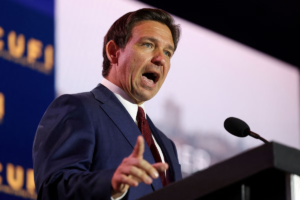Officers continue to use force against Black people more than any other group, a disparity that has worsened this year.
San Francisco police officials struggled to answer questions from the city’s Police Commission when asked how, in a city where Black people make up only 5% of the population, they made up 44% of police use-of-force incidents during the first half of the year, far more than any other race or ethnicity.
From January through June of this year, the San Francisco Police Department reported using force against Black people 502 times, compared with 311 times against Hispanic people, 223 against white people and 80 times against Asian people. SFPD categorized 35 incidents as against other racial groups.
Welcome to our new site design! We’d love to hear what you think about it.Take A Survey
According to the Police Department’s report, which cites 2021 population totals by race, officers were 17 times as likely to use force on a Black person in the city as they were to use force against a white person.
Advertisement
Article continues below this ad
The department also reported using force against people experiencing homelessness 144 times and against juveniles 47 times through the first half of 2023.
“The conclusion is racial bias is playing a role in these disparities,” commission Vice President Max Carter-Oberstone said. The commission instructed the department to “get to the why,” Carter-Oberstone said. The report was not as prescriptive as the commission would’ve liked, he said.
“We got a lot of numbers and explanations about things that are happening,” commissioner Jesus Yáñez said. “But I’m not seeing a plan.”
Police officials pushed back on commissioners who suggested the disparity is strictly the result of racial bias among officers, but could not explain why Black people are so overrepresented in use-of-force data.
The figures are so stark because there are many variables impacting interactions with the public, police Chief Bill Scott said Wednesday, citing population figures, calls for service and other factors. “Offending rates are part of the equation as well.”
Advertisement
Article continues below this ad
The stark racial disparities should not surprise the department or commission, said Phelicia Jones, founder of Wealth and Disparities in the Black Community, a nonprofit that advocates for Black San Franciscans. She said the department ramped up its racial data collection in 2015 due to a state law.
“The commission has known about the disparity for years,” Jones said. “Where is the reduction?”
The San Francisco Police Officers Association is skeptical of the report’s reliability because it compares uses of force to the city’s population instead of to criminal suspects, union president Tracy McCray said in a statement. “The report relies solely on the residential population of the various racial categories instead of looking at who the SFPD comes into contact with,” McCray said. If the commission looked at the racial makeup of crime suspects and arrested individuals, the uses of force against Black people would not seem so disproportionate, she said.
The SFPD report shows there were 10 data analysis projects conducted with outside experts from 2017 to 2021, but SFPD Strategic Management Bureau program manager Jason Cunningham said he was not prepared to answer when asked why racial disparities in the city are so stark. “I think you probably asked the hardest question in social science,” Cunningham said.

SFNext is Chronicle coverage devoted to the city’s most vexing problems.
To become involved: Send feedback, ideas and suggestions to sfnext@SFChronicle.com
Also at the meeting, the commission considered changes to the policy governing when and how police attempt to forcibly stop a vehicle. Proposed changes to the department’s policy being considered by the commission would state that interventions such as roadblocks, spike strips or deliberately colliding with a vehicle are akin to using force against the vehicle’s occupants.
The policy also restricts tire-deflation devices from being used on motorcycles, mopeds and three-wheelers; school and passenger buses with passengers aboard; tow vehicles; and those transporting hazardous material unless “deadly force is appropriate.”
The changes come after two high-profile police chases this spring, one of which ended with four injuries and the death of a bystander.
Shortly after the May 23 death of Victor Nguyen, who was killed when a vehicle being chased by police smashed into a bus stop on the corner of 16th Street and Potrero Avenue, SFPD temporarily banned the preemptive use of spike strips because leadership believed such use was out of policy. The commission responded in September, adopting a resolution declaring using tire deflation to prevent a chase is within policy.
The Get Involved calendar
Search for public meetings on top San Francisco issues so you can add your voice.
Supporters of changing the policy think it will improve public safety, as well as the safety of police officers. An SFPD officer died trying to lay spike strips during a vehicle pursuit in 2006.
Carter-Oberstone, a frequent critic of SFPD policies, described the use of tire-deflation devices as an “unmitigated good.”
The proposed changes were widely accepted by the commission and Scott, but the chief requested a 30-day delay before adopting the policy in light of the upcoming Asia-Pacific Economic Cooperation conference in San Francisco, which will draw officers away from their usual assignments, Scott said. The 30-day delay was approved unanimously.
The commission has also recently modified other elements of the vehicle pursuit policy and implemented a foot chase policy.
Wednesday’s meeting came after a tense few weeks for commissioners. After Breed announced her intention to place a measure on the 2024 ballot to limit the commission’s power, the board split on how to respond. After heated debate, two commissioners appointed by Breed left an Oct. 18 meeting, effectively ending it by preventing a quorum.
The police officers union supports the mayor’s proposal, particularly a provision that would loosen restrictions on surveillance technology the department can use. Adopting such technology “should be a no-brainer,” McCray told the Chronicle in a statement, “not a political sideshow.”
Reach Daniel Lempres: daniel.lempres@sfchronicle.com




